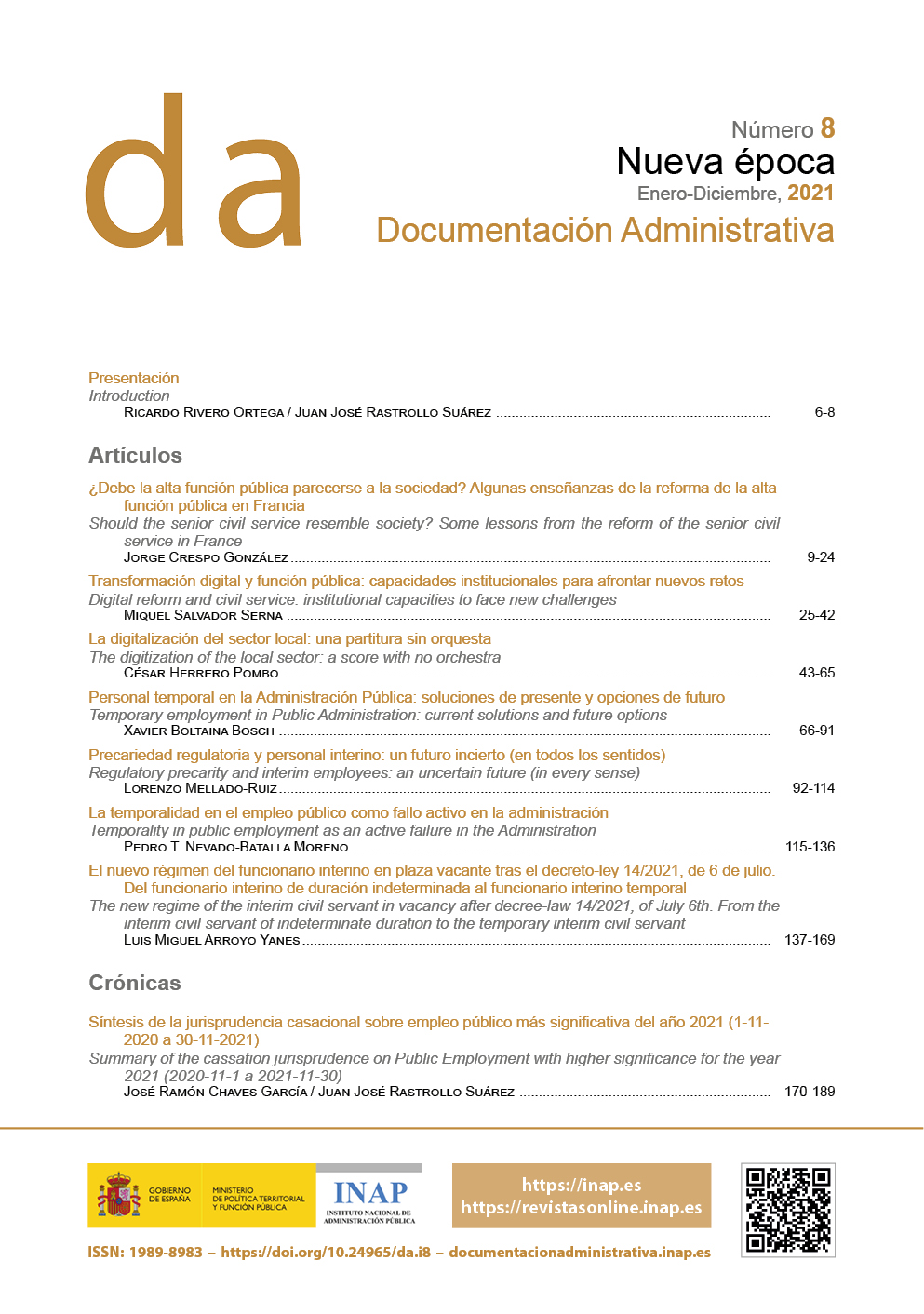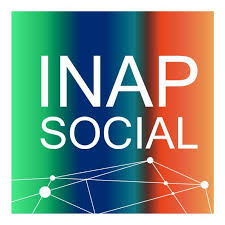Digital reform and civil service: institutional capacities to face new challenges
DOI:
https://doi.org/10.24965/da.i8.11030Keywords:
Civil service, electronic human resources management (e-HRM), human resources analytics, digital transformation, institutional capacitiesAbstract
Digital transformation processes have evolved from technology-focused positions to more comprehensive change approaches. In its application to the field of human resource management, a similar progression appears, from initiatives focused on automation to those aimed at facilitating more substantive changes. The potential for change of this digital transformation is reflected both in the automation of the different personnel management subsystems and in their integration through human resources analytics. To deploy this process in public sector organizations, it is essential to have the appropriate capacities, among which are political and strategic, organizational management and analytics. The confluence makes it possible to point out the bases for the introduction of a change in the civil service model.
Downloads
References
Abia, M. y Brown, I. (2020). Conceptualizations of e-Recruitment: A Literature Review and Analysis. En M. Hattingh, M. Matthee, H. Smuts, I. Pappas, Y. Dwivedi y M. Mäntymäki (eds.), Responsible Design, Implementation and Use of Information and Communication Technology (pp. 370-379). Springer Nature Switzerland.
Acemoglu, D., Garcia-Jimeno, C. y Robinson, J. (2015). State Capacity and Economic Development: A Network Approach. American Economic Review, 105(8), 2364-2409. https://doi.org/10.1257/aer.20140044
Aguado García, D. (2018). Analítica de recursos humanos: Explorando oportunidades a partir del big data y la práctica del «human resources analytics». Revista Vasca de Gestión de Personas y Organizaciones Públicas, 14, 36-51. https://apps.euskadi.eus/z16-a5app2/es/t59auUdaWar/R3/verArticulo?numejem=14&tipo=R&seccion=51&correlativo=1&contenido=4&locale=es
Areses, X., Blanco, C., Colmenares, P., Fernández, E., Gallego, A., Gómez, G., Íñiguez, S., Labrada, M.ª L., Mapelli, C., Pastor, I. y Souto, J. (2017). Nuevos tiempos para la función pública: propuestas para atraer y desarrollar el talento en la Administración General del Estado [colección Monografías]. Instituto Nacional de Administración Pública – INAP.
Ball, K. S. (2001). The use of human resource information systems: a survey. Personnel Review, 30(6), 677-693. https://doi.org/10.1108/EUM0000000005979
Baum, C. y Di Maio, A. (21 de noviembre de 2000). Gartner’s Four Phases of EGovernment Model. Gartner. Recuperado de https://www.gartner.com/doc/317292/gartners-phases-egovernment-model.
Barrett, K., y Greene, R. (2008). Grading the states: The mandate to measure. Governing, 21(6), 24-95. http://www.governing.com/gpp/2008/index.htm
Berber, N., Đorđević, B. y Milanović, S. (2018). Electronic Human Resource Management (e-HRM): А New Concept for Digital Age. Strategic Management, 23(2), 22-32. https://www.smjournal.rs/index.php/home/article/view/28
Bondarouk, T. V., Parry, E. y Furtmueller, E. (2017). Electronic HRM: four decades of research on adoption and consequences. The International Journal of Human Resource Management, 28(1), 98-131. https://doi.org/10.1080/09585192.2016.1245672
Bondarouk, T. V., y Ruël, H. J. M. (2009). Electronic human resource management: Challenges in the digital era. The International Journal of Human Resource Management, 20(3), 505-514. https://doi.org/10.1080/09585190802707235
Brandão, C., Silva, R. y Vieira dos Santos, J. (2019). Online recruitment in Portugal: Theories and candidate profiles. Journal of Business Research, 94, 273-279. https://doi.org/10.1016/j.jbusres.2018.04.011
Broderick, R. y Bodreau, J. W. (1992). Human resource management, information technology, and the competitive edge. Academy of Management Perspectives, 6(2), 7-17. https://doi.org/10.5465/ame.1992.4274391
Criado, J. I. (2009). Europeanization of eGovernment Policy. Institutional Mechanisms and Implications for Public Sector Innovation. Information Polity, 14(4), 315-330. https://doi.org/10.3233/IP-2009-0192
Criado, J. I. y Gil Garcia, J. R. (2019). Creating public value through smart technologies and strategies: From digital services to artificial intelligence and beyond. International Journal of Public Sector Management, 32(5), 438-450. https://doi.org/10.1108/IJPSM-07-2019-0178
Criado, J. I., Ramilo, M. del C. y Salvador, M. (2002). La necesidad de Teoría(s) sobre Gobierno Electrónico. Una propuesta Integradora. XVI Concurso de Ensayos y Monografía del CLAD sobre Reforma del Estado y Modernización de la Administración Pública «Gobierno Electrónico». http://siare.clad.org/fulltext/0043103.pdf
Cuenca, J. (2018). Instrumentos de planificación de recursos humanos y selección: ¿cambio de paradigma? Revista Vasca de Revista Vasca de Gestión de Personas y Organizaciones, 2/2018 (número Especial), 52-65. https://apps.euskadi.eus/z16-a5app2/es/t59auUdaWar/R3/verArticulo?numejem=3&tipo=S&seccion=51&correlativo=1&contenido=2&locale=es
Dani, M. y Ghatpande, K. (2020). e-HRM: An Expanded Role of Contemporary HRM. CLIO: Annual Interdisciplinary Journal of History, 6(5), 310-316.
Deshwall, P. (2015a). The rise of e-HRM. International Journal of Applied Research, 1(9), parte P, 1074-1076. https://www.allresearchjournal.com/archives/2015/vol1issue9/PartP/1-12-93.pdf
Deshwall, P. (2015b). Role of e-HRM in Organizational Effectiveness and Sustainability. International Journal of Applied Research, 1(12), parte I, 605-609. https://www.allresearchjournal.com/archives/2015/vol1issue12/PartI/1-12-77.pdf
Di Maio, A. y Howard, R. (2017). Introducing the Gartner Digital Government Maturity Model 2.0. Gartner. https://www.gartner.com/doc/3764382/introducing-gartner-digital-government-maturity
Eggers, W. D. y Bellman, J. (2015). Digital government transformation. The journey to government’s digital future. Deloitte University Press. https://www2.deloitte.com/content/dam/Deloitte/global/Documents/About-Deloitte/gx-global-findings-digital-government-transformation.pdf
Evans, P. B. (1992). The state as problem and solution: predation, embedded autonomy, and adjustment. En S. Haggard y R. R. Kaufman (eds.), The politics of economic adjustment (pp. 139-191). Princeton University Press.
Falk, S., Römmele, A. y Silverman, M. (2017). The Promise of Digital Government. En S. Falk, A. Römmele y M. Silverman (eds.), Digital Government: Leveraging Innovation to Improve Public Sector Performance and Outcomes for Citizens (pp. 3-24). Springer.
Falletta, S. V. y Combs, W. L. (2020). The HR analytics cycle: a seven-step process for building evidence-based and ethical HR analytics capabilitie. Journal of Work-Applied Management (en prensa). https://doi.org/10.1108/JWAM-03-2020-0020
Findikli, M. A. y Bayarçelikb, E. B. (2015). Exploring the outcomes of Electronic Human Resource Management (e-HRM)? Procedia – Social and Behavioral Sciences, 207, 424-431. https://doi.org/10.1016/j.sbspro.2015.10.112
Galanaki, E., Lazazzara, A. y Parry, E. (2019). A Cross-National Analysis of e-HRM Configurations: Integrating the Information Technology and HRM Perspectives. En A. Lazazzara, R. Nacamulli, C. Rossignoli y S. Za (eds.), Organizing for Digital Innovation. At the Interface Between Social Media, Human Behavior and Inclusion [serie Lecture Notes in Information Systems and Organisation – LNISO] (vol. 27, pp. 261-276). Springer. https://doi.org/10.1007/978-3-319-90500-6_20
Galindo, R. (2019). Big data e inteligencia artificial en la gestión de los recursos humanos del sector público. Revista Catalana de Dret Públic, 58, 49-63. http://dx.doi.org/10.2436/rcdp.i58.2019.3276
Garcia-Arroyo, J. y Osca, A. (2019). Big data contributions to human resource management: a systematic review. The International Journal of Human Resource Management, 32(20), 4337-4362. https://doi.org/10.1080/09585192.2019.1674357
Gil-Garcia, J. R., Zhang, J. y Puron-Cid, G. (2016). Conceptualizing smartness in government: An integrative and multi-dimensional view. Government Information Quarterly, 33(3), 524-534. https://doi.org/10.1016/j.giq.2016.03.002
González, J. C. y Gutiérrez, M. (2016). Formación innovadora [Innap innova] (2.ª ed.). Instituto Nacional de Administración Pública – INAP. https://bci.inap.es/material-formaci%C3%B3n-innovadora-juan-carlos-gonz%C3%A1lez-gonz%C3%A1lez-libro-electr%C3%B3nico
Hill, N. S., Kang, J. H. y Seo, M.-G. (2014). The interactive effect of leader-member exchange and electronic communication on employee psychological empowerment and work outcomes. The Leadership Quarterly, 25(4), 772-783.
Hiller, J. S. y Bélanger, F. (2001). Privacy strategies for electronic government. PwC Endowment for the Business of Government. https://www.businessofgovernment.org/sites/default/files/PrivacyStrategies.pdf
Hosain, M. S. (2017). The impact of e-HRM on organizational performance: evidence from selective service sectors of Bangladesh. International Journal of Human Resources Management, 6(3), 1-14.
Hussain, Z., Wallace, J. y Cornelius, N. E. (2007). The use and impact of human resource information systems on human resource professionals. Information & Management, 44(1), 74-89. https://doi.org/10.1016/j.im.2006.10.006
Ingrassia, R. (2017). L’Employer Branding nelle organizzazioni pubbliche. Rivista Trimestrale di Scienza dell’Amministrazione, 2/2017, 1-22. http://rtsa.eu/RTSA_2_2017_Ingrassia.pdf
Janowski, T. (2015). Digital government evolution: From transformation to contextualization. Government Information Quarterly, 32(3), 221-236. https://doi.org/10.1016/j.giq.2015.07.001
Jiménez Asensio, R. (2018). «Repensar» la selección de empleados públicos: momento actual y retos de futuro. Revista Vasca de Gestión de Personas y Organizaciones Públicas, 2/2018 (número especial), 8-29. https://apps.euskadi.eus/z16-a5app2/es/t59auUdaWar/R3/verArticulo?numejem=3&tipo=S&seccion=60&correlativo=1&contenido=1&locale=es
Kohansal, M. A., Sadegh, T. y Haghshenas, M. (2016). e-HRM: From acceptance to value Creation. Journal of Information Technology Management, XXVII(1), 18-27. http://doi.org/10.17697/ibmrd/2014/v3i1/46898
Kulkarni, S. R. (2014). Human Capital Enhancement through e-HRM. IBMRD’s Journal of Management and Research, 3(1), 59-74. http://ibmrdjournal.in/index.php/ibmrd/article/view/46898
Layne, K. y Lee, J. (2001). Developing fully functional e-Government: A four stage model. Government Information Quarterly 18(2), 122-136. https://doi.org/10.1016/S0740-624X(01)00066-1
Lee, J. (2010). 10-year retrospect on stage models of e-Government: A qualitative meta-synthesis. Government Information Quarterly, 27(3), 220-230. https://doi.org/10.1016/j.giq.2009.12.009
Lei, Z. y Jing, Y. (2016). Study on human resource reform in the digital transformation [Proceedings of the 2016 Joint International Information Technology, Mechanical and Electronic Engineering]. AER – Advances in Engineering Research, 59, 471-477.
Lindgren, I. y Van Veenstra, A. F. (mayo de 2018). Digital government transformation: a case illustrating public e-Service development as part of public sector transformation. Proceedings of the 19th Annual International Conference on Digital Government Research: Governance in the Data Age, artículo 38, 1-6. https://doi.org/10.1145/3209281.3209302
Lodge, M. y Wegrich, K. (2014). Introduction: Governance Innovation, Administrative Capacities, and Policy Instruments. En M. Lodge y K. Wegrich (eds.), The Problem-solving Capacity of the Modern State (pp. 16-26). Oxford University Press. http://doi.org/10.1093/acprof:oso/9780198716365.003.0001
Lowndes, N. (26 de julio de 2021). Making digital transformation work: Drivers and barriers in HRM digitalization. Academy of Management Proceedings, 21(1). https://doi.org/10.5465/AMBPP.2021.13464abstract
Luna-Reyes, L. F. (2017). Opportunities and challenges for digital governance in a world of digital participation. Information Polity 22(2), 1-9.
Luna-Reyes, L. F. y Gil-Garcia, J. R. (2014). Digital government transformation and internet portals: The co-evolution of technology, organizations, and institutions. Government Information Quarterly, 31(4), 545-555. https://doi.org/10.1016/j.giq.2014.08.001
Luna-Reyes, L. F., Picazo-Vela, S., Luna, D. E. y Gil-Garcia, J. R. (5-8 de enero de 2016). Creating public value through digital government: lessons on inter-organizational collaboration and information technologies. En 49th Hawaii International Conference on System Sciences (HICSS) (pp. 2840-2849). https://doi.org/10.1109/HICSS.2016.356
Luna-Reyes, L. F. y Gil-Garcia, J. R. (2014). Digital government transformation and internet portals: The co-evolution of technology, organizations, and institutions. Government information quarterly, 31(4), 545-555. https://doi.org/10.1016/j.giq.2014.08.001
Mayne, Q., De Jong, J. y Fernandez-Monge, F. (2020). State Capabilities for Problem-Oriented Governance. Perspectives on Public Management and Governance, 3(1), 33-44. https://doi.org/10.1093/ppmgov/gvz023
Monteiro, I. P., Correia, M. B. y Gonçalves, C. (2019). Transforming a company’s staffing process: implementing e-Recruitment. Journal of Spatial and Organizational Dynamics, 7(2), 144-157. https://www.jsod-cieo.net/journal/index.php/jsod/article/view/186
Nograšek, J. y Vintar, M. (2014). e-Government and organizational transformation of government: Black box revisited? Government Information Quarterly, 31(1), 108-118. https://doi.org/10.1016/j.giq.2013.07.006
Norris, D. F. (1-4 de noviembre de 2009). e-Government among American local governments: Adoption, impacts, barriers and lessons learned. The International Conference for Administrative Development: Towards Excellence in Public Sector Performance.
Marler, J. H. y Boudreau, J. W. (2017). An evidence-based review of HR Analytics. The International Journal of Human Resource Management, 28(1), 3-26. https://doi.org/10.1080/09585192.2016.1244699
Marler, J. H. y Parry, E. (2016). Human resource management, strategic involvement and e-HRM technology. The International Journal of Human Resource Management, 27(19), 2233-2253. https://doi.org/10.1080/09585192.2015.1091980
Mergel, I., Edelmannb, N. y Hauga, N. (2019). Defining digital transformation: Results from expert interviews. Government Information Quarterly, 36(4), artículo 101385. https://doi.org/10.1016/j.giq.2019.06.002
Meijer, A. y Bekkers, V. (2015). A metatheory of e-Government: Creating some order in a fragmented research field. Government Information Quarterly, 32(3), 237-245. https://doi.org/10.1016/j.giq.2015.04.006
Micu, A., Capatina, A., Micu, A. E. y Schin, G. (2017). Exploring e-HCM Systems’ Benefits in Organizations from Private Sector and Public Administration. Journal of Promotion Management, 23(3), 407-418. https://doi.org/10.1080/10496491.2017.1294885
Misuraca, G. (ed.) (2019). Exploring Digital Government transformation in the EU – Analysis of the state of the art and review of literature (EUR 29987 EN). Publications Office of the European Union. https://doi.org/10.2760/17207
Misuraca, G., Savoldelli, A. y Codagnone, C. (2014). Evaluating e-Government: A Comprehensive Methodological Framework to Assess Policy Impacts. En L. Anthopoulos y C. Reddick (eds.), Government e-Strategic Planning and Management. Public Administration and Information Technology (vol. 3, pp. 25-47). Springer. https://doi.org/10.1007/978-1-4614-8462-2_2
Misuraca, G., Codagnone, C. y Rossel, P. (2013). From practice to theory and back to practice: Reflexivity in measurement and evaluation for evidence-based policy making in the information society. Government Information Quarterly, 30(Suplement 1), S68-S82. https://doi.org/10.1016/j.giq.2012.07.011
OECD (2016). Digital Government Strategies for Transforming Public Services in the Welfare Areas [Report OECD Comparative Study]. https://www.oecd.org/gov/digital-government/Digital-Government-Strategies-Welfare-Service.pdf
Oswal, N. y Narayanappa, G. L. (2014). Evolution of HRM to e-HRM towards organizational effectiveness and sustainability. International Journal of Recent Development in Engineering and Technology, 2(número especial 4), 7-14. https://www.ijrdet.com/files/IRCESM2014/IJRDET_IRCESM_02.pdf
Parry, E. (2011). An examination of e-HRM as a means to increase the value of the HR function. The International Journal of Human Resource Management, 22(5), 1146-1162. https://doi.org/10.1080/09585192.2011.556791
Payne, S. C., Horner, M. T., Boswell, W. R., Schroeder, A. N. y Stine-Cheyne, K. J. (2009). Comparison of online and traditional performance appraisal systems. Journal of Managerial Psychology, 24(6), 526-544. https://doi.org/10.1108/02683940910974116
Rahman, M., Mordi, Ch. y Nwagbara, U. (2017). Factors influencing E-HRM implementation in government organisations. Journal of Enterprise Information Management, 31(2), 247-275. https://www.emerald.com/insight/content/doi/10.1108/JEIM-05-2017-0066/full/html
Ramesh, M., Saguin, K., Howlett, M. P., Wu, X. (2016). Rethinking Governance Capacity as Organizational and Systemic Resources. Lee Kuan Yew School of Public Policy (paper número 16-12). http://dx.doi.org/10.2139/ssrn.2802438
Ramió, C. y Salvador, M. (2019). Una Gobernanza Social e Inteligente. Una nueva organización para el Ayuntamiento de Barcelona. Ajuntament de Barcelona.
Ramió, C. y Salvador, M. (2018). La nueva gestión del empleo público. Recursos humanos e innovación de la Administración. Tibidabo ediciones.
Ramírez, O. y Salvador, M. (2016). ¿Del gobierno digital al gobierno abierto? Iniciativas para transformar la gestión de recursos humanos con un componente tecnológico y cambio institucional. En Criado, J. I. (ed.). Nuevas tendencias en la gestión pública. Innovación abierta, gobernanza inteligente y tecnologías sociales en unas administraciones públicas colaborativas (1.ª ed., pp. 68-87). Instituto Nacional de Administración Pública – INAP.
Reina, R., Scarozza, D. (2021). Human Resource Management in the Public Administration. En M. Decastri, S. Battini, F. Buonocore, y F. Gagliarducci (eds.), Organizational Development in Public Administration (pp. 61-101). Palgrave Macmillan.
Riera-Ortiz, A. y Páez, A. E. (2010). Innovación, burocracia y gobierno electrónico en la administración pública. Hologramática, 12(2), 25-42. https://www.cienciared.com.ar/ra/usr/3/895/hologramatica_n12vol2pp25_42.pdf
Salvador, M. (2021). Capacidades institucionales para afrontar las infraestructuras organizativa y ética de la inteligencia artificial en las Administraciones públicas. En AA.VV, Inteligencia artificial y ética en la gestión pública (1.ª ed., pp. 45-74). Centro Latinoamericano de Administración para el Desarrollo, CLAD. https://clad.org/wp-content/uploads/2021/03/Libro-7-Inteligencia-artificial-y-%C3%A9tica-en-la-gesti%C3%B3n-p%C3%BAblica.pdf
Salvador, M. (2020). ¿Estamos preparados para la incorporación efectiva del teletrabajo en las organizaciones públicas?: el aporte de las capacidades institucionales. Consultor de los ayuntamientos y de los juzgados: Revista técnica especializada en administración local y justicia municipal, Extra 5 (Ejemplar dedicado a: Teletrabajo en el sector público: una herramienta transversal), 56-65.
Salvador, M. (2008). La dimensión interna del gobierno electrónico y el impacto de la e-administración en la gestión de los recursos humanos: ¿están cambiando las reglas del juego? Revista Administración y Ciudadanía, 2(3), 185-198. https://egap.xunta.gal/revistas/AC/article/view/3355
Salvador, M. y Ramió, C. (2020). Capacidades analíticas y gobernanza de datos en la Administración pública como paso previo a la introducción de la Inteligencia Artificial. Reforma y Democracia, revista del CLAD, 77, 5-36. https://clad.org/wp-content/uploads/2021/04/077-01-SR.pdf
Salvador, M. y Ramírez, O. (2016). Gobierno abierto y competencias digitales: transformando la administración pública para afrontar los retos del nuevo paradigma. Cuadernos de Gobierno y Administración Pública, 3(1): 1-13. https://doi.org/10.5209/CGAP.52992
Savoia, A. y Sen, K. (2015). Measurement, evolution, determinants, and consequences of state capacity: A review of recent research. Journal of Economic Surveys, 29(3), 441-458. https://doi.org/10.1111/joes.12065
Škudienė, V., Vezeliene, G. Stangej, O. (2020). Transforming human resource management: innovative e-HRM value creation for multinational companies. En V. Škudienė, J. Li-Ying y F. Bernhard (eds.), Innovation Management. Perspectives from Strategy, Product, Process and Human Resources Research (pp.140-166). Edward Elgar.
Scholl, H. J. (2010). Electronic government: A study domain past its infancy. En H. J. Scholl (ed.), e-Government: Information, technology, and transformation (11-32), M. E. Sharpe.
Scholl, H. J. y Dwivedi, Y. K. (2014). Forums for electronic government scholars: Insights from a 2012/2013 study. Government Information Quarterly 31(2), 229-242. https://doi.org/10.1016/j.giq.2013.10.008
Skocpol, T. y Finegold, K. (1982). State capacity and economic intervention in the early New Deal. Political Science Quarterly, 97(2), 255-278. https://doi.org/10.2307/2149478
Strohmeier, S. (2020). Digital human resource management: A conceptual clarification. German Journal of Human Resource Management, 34(3), 345-365. https://doi.org/10.1177/2397002220921131
Strohmeier, S. (2009). Concepts of e-HRM consequences: a categorization, review and suggestion. The International Journal of Human Resource Management. 20(3), 528-543. https://doi.org/10.1080/09585190802707292
Strohmeier, S. y Kabst, R. (2014). Configurations of e-HRM. An empirical exploration. Employee Relations, 36(4), 333-353. https://doi.org/10.1108/ER-07-2013-0082
Strohmeier, S. y Kabst, R. (2012). Evaluating major design characteristics of human resource information systems. International Journal of Business Information Systems, 9(3), 328-342. https://www.inderscienceonline.com/doi/abs/10.1504/IJBIS.2012.045721
Twizeyimana, J. D. y Andersson, A. (2019). The public value of e-Government – a literature review. Government Information Quarterly, 36(2), 167-178. https://doi.org/10.1016/j.giq.2019.01.001
Ukandu, N. E., Iwu, C. G. y Allen-lle, C. O. K. (2014). Influence of e-HRM in decision making in selected tertiary institutions in South Africa. Problems and Perspectives in Management, 12(4), 397-405.
Umar, T. A., Yammama, B. A. y Shaibu, R. O. (2020). The Implications of Adopting and Implementing Electronic Human Resource Management Practices on Job Performance. Journal of Human Resource Management, 8(2), 96-108. https://www.sciencepublishinggroup.com/journal/paperinfo?journalid=176&doi=10.11648/j.jhrm.201200802.17
UNITED NATIONS (2018). UN e-Government Survey (consultado el 06-04-2020). https://www.un.org/development/desa/publications/2018-un-e-government-survey.html
UNITED NATIONS DEVELOPMENT PROGRAMME – UNDP (2010). Measuring Capacity. UNDP. https://www.undp.org/content/undp/en/home/librarypage/capacity-building/undp-paper-on-measuring-capacity.html (consultado el 06-04-2020).
Valdés, G., Solar, M., Astudillo, H., Iribarren, M., Concha, G. y Visconti, M. (2011). Conception, development and implementation of an e-Government maturity model in public agencies. Government Information Quarterly, 28(2), 176-187. https://doi.org/10.1016/j.giq.2010.04.007
Williams, M. y Valayer, C. (2018). Digital Government Benchmark. Study on Digital Government Transformation [report]. DG Joint Research Centre, European Commission. https://joinup.ec.europa.eu/collection/elise-european-location-interoperability-solutions-e-government/document/report-digital-government-benchmark-study-digital-government-transformation
Zhang, X. y Venkatesh, V. (2014). Explaining Employee Job Performance: The Role of Online and Offline Workplace Communication Networks. MIS Quarterly, 37(3), 695-722. https://www.jstor.org/stable/43825996
Zhou, Y., Liu, R., Chang, X. y Wang, L. (2020). The impact of HRM digitalization on firm performance: investigating three-way interactions. Asia Pacific Journal of Human Resources, 59(1), 20-43. http://doi.org/10.1111/1744-7941.12258
Downloads
Published
How to Cite
Issue
Section
License
Copyright (c) 2021 Documentación Administrativa

This work is licensed under a Creative Commons Attribution-NonCommercial 4.0 International License.











